Ecosystems are constantly evolving in response to various changes in the environment.
In NakamuLab, we study the coral reef, seagrass, and mangrove areas in order to gain a better understanding of related ecosystem processes, which vary in their complexity. We conduct ecological surveys, monitor water quality, and perform laboratory and in-situ experiments, applying a variety of geochemical techniques and sensors. We are also developing an integrated modelling system for our ecosystems of interest, which can be used to make predictions for possible future scenarios, as well as hindcast conditions for important events in the past. Through our research efforts, we aim to support ongoing research on global environmental changes linked to global warming and ocean acidification, dynamics of ecosystems under anthropogenic influence, and the establishment of a sustainable human-ecological system.
In the environment surrounding reef-building corals, various physicochemical factors and stresses interact in a complex manner. If we attempt to evaluate their influences in say, a breeding experiment, a large number and combination of experiments will be necessary. Furthermore, it is known that water temperature, carbon cycling, and nutrient concentrations in coral reef areas can fluctuate dynamically, and hence it would be very difficult to evaluate such interactions solely using breeding experiments.
We therefore consider the modeling approach as an effective method to describe the elementary processes of the coral response to each environmental factor and evaluate their compound effects and potential stresses on the coral organism. Based on this approach, we are currently developing a coral polyp model that describes in detail the physics, chemistry, and elementary physiological processes involved in the coral internal responses. The conceptual diagram is show below.
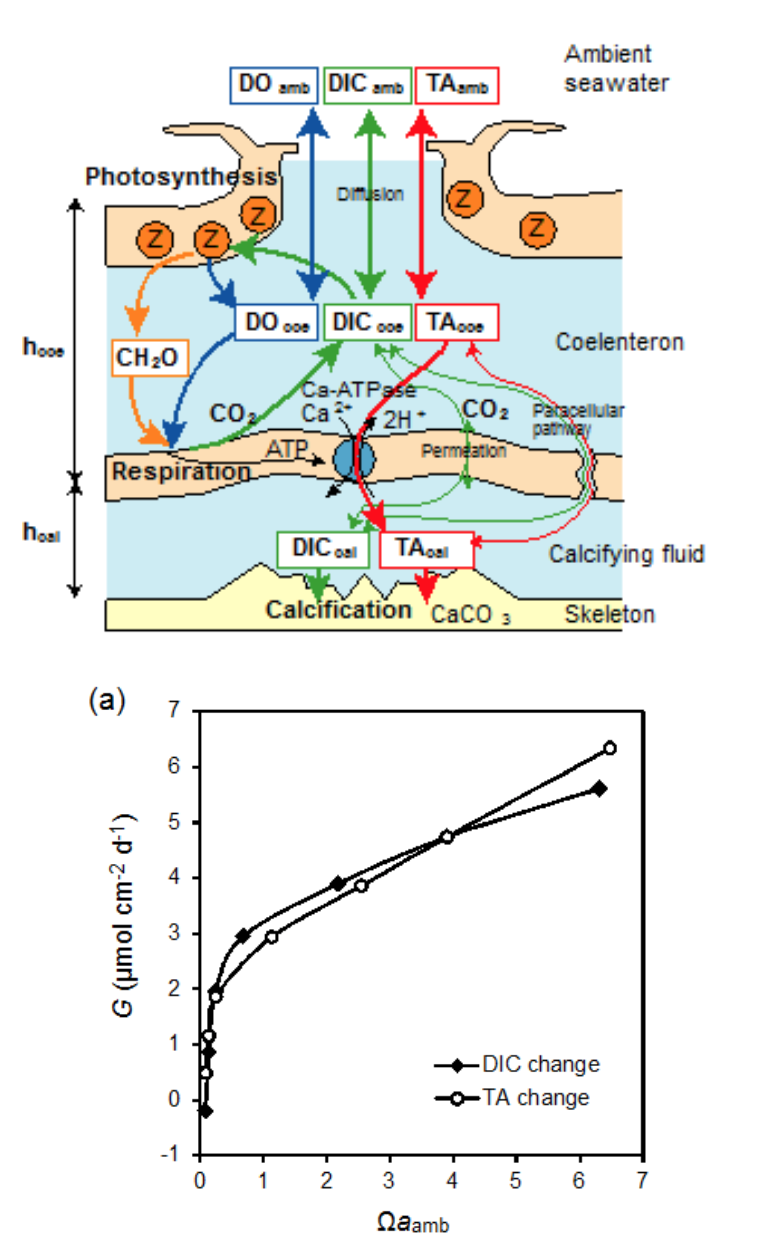
Schematic of the coral polyp model (top) and the calcification response to aragonite saturation (bottom) (Nakamura et al. 2013)
At present, this model can reproduce basic responses related to coral calcification, such as photosynthesis, respiration, and light-enhanced calcification, metabolic response to flow, response in a closed environment, and the expected response to ocean acidification.
Therefore, to evaluate the coral response to various environmental changes, we continue to work towards elucidating the elementary processes related to the response to stresses such as abnormally high water temperature which can cause coral bleaching (a phenomenon in which a coral releases/digests symbiotic algae known as zooxanthella which provide much of the coral’s nourishment; if such a state persists, the coral will eventually die), excessive nutrient loading from terrestrial areas, and red-soil runoff.
The term "Blue Carbon" has been increasingly gaining scientific interest in recent years, and it refers to how shallow-water ecosystems accumulate large amounts of carbon. It is also known that various types of organic matter are widely dispersed in such areas due to high levels of biological activity. By applying various geochemical methods in coral reef, seagrass, and mangrove areas, such as 24-hour or spatial water sampling, mesocosm experiments, and core sampling, it may be possible to estimate the fluxes of carbon, nitrogen, phosphorus, and so on, between different compartments in the ecosystem. Through our research, we hope to properly quantify how much is accumulated in each compartment as well as the inflow and outflow fluxes into and out of the system, and elucidate whether such is taken in, accumulated, or otherwise returned to the environment.
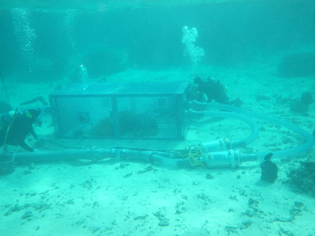
Coral reef in-situ mesocosm experiment
In extremely shallow waters, such as found in coral reef areas, water flow characteristics, thermal environments, water quality, among other factors, can experience dynamic changes. In order to investigate how the coral reef ecosystem responds to the environment under such dynamic fluctuations, we have been developing an integrated model of the coral reef ecosystem in which the above-mentioned coral polyp model is combined with a 3-D hydrodynamic circulation and water quality simulation model.
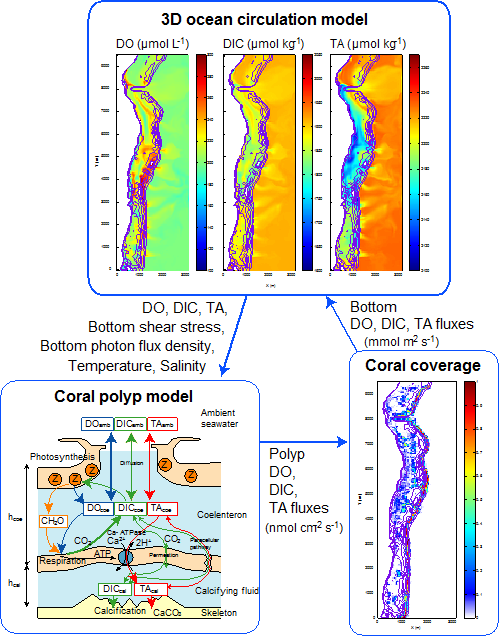
Reef-scale integrated coral reef ecosystem model overview (Nakamura, 2020)
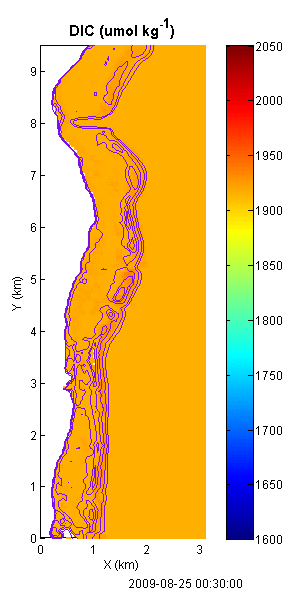
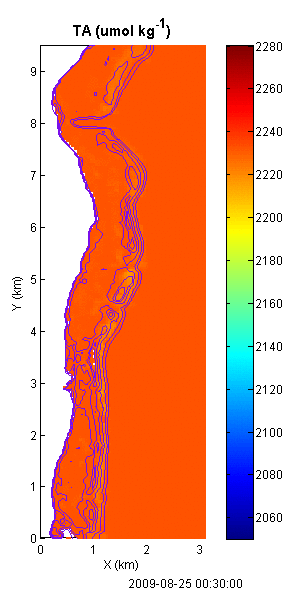
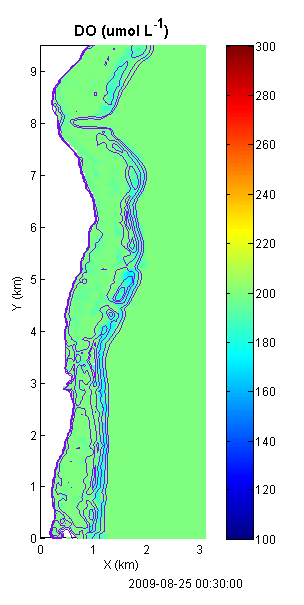
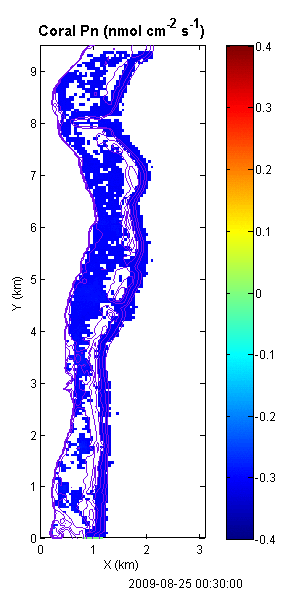
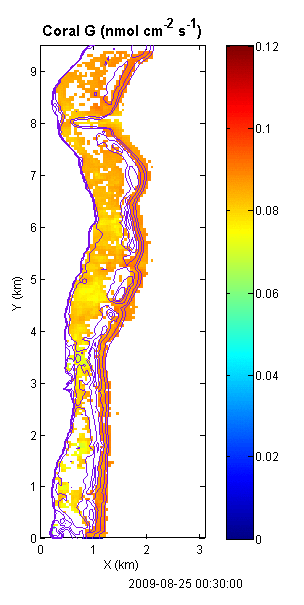
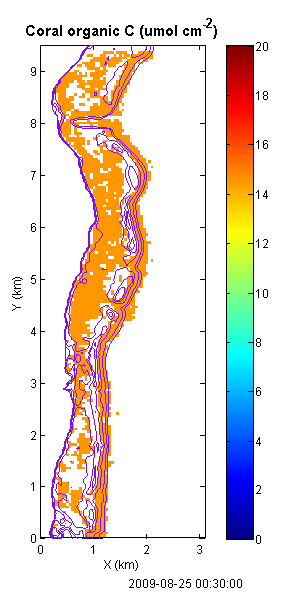
Dissolved inorganic carbon (DIC), total alkalinity (TA), and dissolved oxygen concentration (DO) simulated using a 3-D circulation model (top row), and net photosynthetic rate (Pn), calcification rate (G), and coral organic carbon storage calculated by coral polyp model (bottom row) for the Shiraho coral reef area.
The figure above shows simulation results from the integrated model system we have been developing. The results confirm that coral metabolism exhibits spatiotemporal fluctuations in response to changes in water quality, which are driven by local water flow environments. From this we can say that the coral polyp model's best feature is the ability to reproduce the coral community response to the environment.
We are continuing to advance this system, and plan to conduct various scenario analyses and similar nutrients.
=> For more details, please click :
YAEYAMA3: Sea surface/bottom temperature
=> For more details, please click :
YAEYAMA2: Sea surface/bottom temperature
=> For more details, please click :
To understand the bay environment of Shizugawa Bay in Minamisanriku Town, Miyagi Prefecture, we conduct field observations and develop models based on the following problem awareness and framework:
For more details, please visit here
=> For more details, please click :
=> For more details, please click :
=> For more details, please click :
Integrated Model Development for Coral Reef Ecosystems
In extremely shallow waters often found in reef areas, various physiochemical factors including water flow characteristics, thermal environments, and water quality undergo dynamic changes. In order to understand how a coral reef ecosystem responds to the environment under such dynamic fluctuations, an integrated model based on simulation and onsite observation must be the key.
created with
WordPress Website Builder .